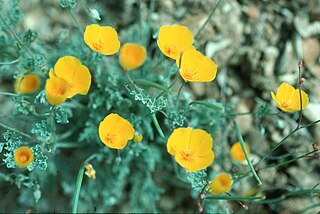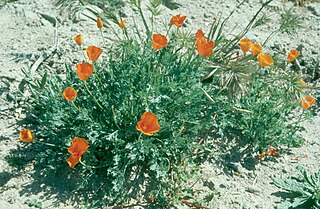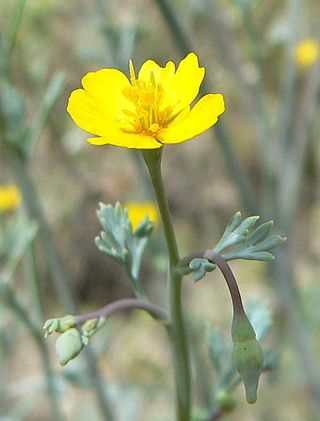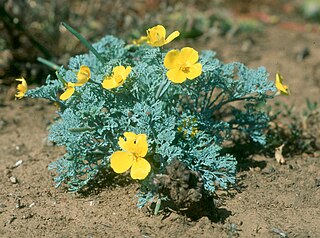
Eschscholzia californica, the California poppy, golden poppy, California sunlight or cup of gold, is a species of flowering plant in the family Papaveraceae, native to the United States and Mexico. It is cultivated as an ornamental plant flowering in summer, with showy cup-shaped flowers in brilliant shades of red, orange and yellow. It is also used as food or a garnish. It became the official state flower of California in 1903.

Eschscholzia is a genus of 12 annual or perennial plants in the Papaveraceae (poppy) family. The genus was named after the Baltic German/Imperial Russian botanist Johann Friedrich von Eschscholtz (1793–1831). All species are native to Mexico or the southern United States.

A wildflower is a flower that grows in the wild, meaning it was not intentionally seeded or planted. The term implies that the plant is neither a hybrid nor a selected cultivar that is any different from the native plant, even if it is growing where it would not naturally be found. The term can refer to the whole plant, even when not in bloom, and not just the flower.

Ctenochasma is a genus of Late Jurassic ctenochasmatid pterosaur belonging to the suborder Pterodactyloidea. Three species are currently recognized: C. roemeri, C. taqueti, and C. elegans. Their fossilized remains have been found in the Solnhofen Limestone of Bavaria, Germany, the "Purbeck Group" of northeastern Germany, and the Calcaires tâchetés of eastern France.

Edward Lee Greene was an American botanist known for his numerous publications including the two-part Landmarks of Botanical History and the describing of over 4,400 species of plants in the American West.

Anticlea elegans, formerly Zigadenus elegans, is also known as mountain deathcamas, elegant camas or alkali grass. It is not a grass, but belongs to the trillium family, Melanthiaceae.

Eschscholzia caespitosa is a species of poppy known by the common names foothill poppy, tufted poppy and collarless California poppy.

Eschscholzia glyptosperma is a species of poppy known by the common names desert gold poppy, desert golden poppy, and Mojave poppy.

Eschscholzia hypecoides is a species of poppy known by the common name San Benito poppy.

Eschscholzia lemmonii is a species of poppy known by the common name Lemmon's poppy.

Eschscholzia lobbii is a species of poppy known by the common name frying pans. It is endemic to California, where it grows in the Central Valley and adjacent Sierra Nevada foothills. The frying pans is a small annual herb growing from a patch of segmented leaves with pointed leaflets. It produces erect stalks up to 15 centimeters in height each bearing a single poppy flower. The petals are about a centimeter long and bright yellow to somewhat orange. The fruit is a capsule 3 to 7 centimeters long containing tiny brown seeds.

Eschscholzia minutiflora is a species of poppy known by the common name pygmy poppy.

Eschscholzia ramosa is a species of poppy known by the common name Channel Islands poppy, or simply island poppy.

Eschscholzia parishii, with the common name Parish's poppy, is an annual desert wildflower in the Poppy family (Papaveraceae), native to several North American desert regions.

Calochortus elegans is a species of flowering plant in the lily family known by the common name elegant Mariposa lily, cat's ear, elegant cat's ears or star tulip. It is native to the western United States from northern California to Montana.

Mutinus elegans, commonly known as the elegant stinkhorn, the dog stinkhorn, the headless stinkhorn, or the devil's dipstick, is a species of fungus in the Phallaceae (stinkhorn) family. The fruit body begins its development in an "egg" form, resembling somewhat a puffball partially submerged in the ground. As the fungus matures, a slender orange to pink colored stalk emerges that tapers evenly to a pointed tip. The stalk is covered with a foul-smelling slimy green spore mass on the upper third of its length. Flies and other insects feed upon the slime which contains the spores, assisting in their dispersal.

Figueroa Mountain is a summit in Santa Barbara County in the U.S. state of California. It is in the San Rafael Mountains, part of the Transverse Ranges group of ranges. The mountain is located in Los Padres National Forest.

Papaveroideae is a subfamily of the family Papaveraceae.

Bauruemys is an extinct genus of turtles in the family Podocnemididae.


















